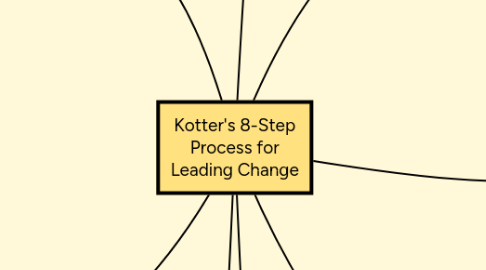
1. 2. Create the guiding coalition (Put together a group with enough power to lead the change).
1.1. Four qualities of a guiding coalition:
1.1.1. Position Power - Enough key players, so those left out cannot block progress.
1.1.2. Expertise - All relevant points of view are represented so that informed decisions can be made.
1.1.3. Credibility - The group should be seen and respected so that the group's actions are taken seriously.
1.1.4. Leadership - The group should have enough proven leaders able to drive the change process.
1.2. This is too big of a job for just one person.
1.2.1. Text book, exercises 34, 35, 36, 37
1.3. Teams are important for decision-making.
1.4. Team members must trust each other
1.5. Team members need to believe in a shared goal.
2. 1. Create a sense of urgency (Help others feel a gut-level determination to move and win, now).
2.1. True Urgency: People are focused on making real progress every day. It's driven by the belief that the world contains great opportunities and great hazards.
2.2. Things leaders can do:
2.2.1. "Aim for the heart" and connect to the deepest values of their people.
2.2.2. Inspire people to greatness.
2.2.3. Engage the senses.
2.2.4. Create messages that are simple and imaginative.
2.2.5. Call people to aspire.
3. 8. Make it stick (Anchor the new approaches in the culture for sustained change).
3.1. Cultural change comes last, not first. Changes are difficult to ingrain and must grow deep roots in order to remain firmly planted in the culture.
3.1.1. Research and prepare experiment
3.2. You must be able to prove that the new way is superior to the old.
3.3. The success must be visible and well communicated
3.4. You will lose some people in the process.
3.5. You must reinforce new norms and values with incentives and rewards, including promotions.
3.6. Reinforce the culture with every new employee.
4. 3. Develop a change vision (Clarify how the future will be different from the past).
4.1. Simplifies detailed decisions, motivates people to act, helps coordinate the effort in an efficient manner.
4.2. The vision is "the glue' that holds parts of the larger system together.
4.3. Six key characteristics
4.3.1. Imaginable; - Convey a clear picture of what the future will look like.
4.3.2. Desirable - Appeal to the long-term interest of stakeholders.
4.3.3. Feasible - Ambitious goals that are still realistic and attainable.
4.3.4. Focused - Clear enough to provide guidance in decision-making.
4.3.5. Flexible - Allow individual initiative and alternative responses in light of changing conditions.
4.3.6. Communicable - Are easy to communicate and explain quickly.
5. 4. Communicate the vision for buy-in (Ensure that as many people as possible understand and accept the vision).
5.1. The vision must be communicated anywhere and everywhere.
5.1.1. Midterm
5.2. Leaders use every communication channel possible to broadcast the vision.
5.3. Leaders 'walk the talk" and model the vision to others by backing up their words with their behaviors. These actions increase motivation, inspire confidence, and decrease cynicism
5.4. The vision is communicated in a way that is:
5.4.1. Simple - no jargon.
5.4.2. Vivid - with verbal pictures like metaphors, analogies, and examples.
5.4.3. Repeatable - Ideas should be able to be spread by anyone to anyone.
6. 5. Empower broad-based action (Remove as many barriers as possible and unleash people to do their best work).
6.1. Deal with Structural Barriers
6.1.1. Realigning incentives and performance appraisals to reflect the vision can have a profound effect on the ability to accomplish the vision.
6.1.2. Up-to-date competitive information and market analysis and the ability to communicate powerfully and effectively throughout the company in a cost effective way can speed up feedback loops and provide information necessary for people to do their jobs more efficiently.
6.2. Deal with troublesome supervisors.
6.2.1. Style of management inhibits change. No easy solution exists here, but the best thing to do is have honest dialogue.
7. 7. Don't let up! (Consolidate gains and produce more change).
7.1. Resistance is always waiting in the wings to re-assert itself. Resistors may wait underground for an opportunity to emerge when you least expect it.
7.2. If you let up before the job is done, you may lose momentum and regress. If this happens, it's difficult to rebuild momentum.
7.3. Good leadership is invaluable in this step
7.3.1. Good leaders will launch more projects to drive the change deeper into the organization.
7.3.2. They will ensure that all new practices are firmly grounded into the culture of the organization.
7.3.3. Leaders must steer the course for the long-term.
7.3.4. Without sufficient, consistent leadership, the change will stall and may not succeed
